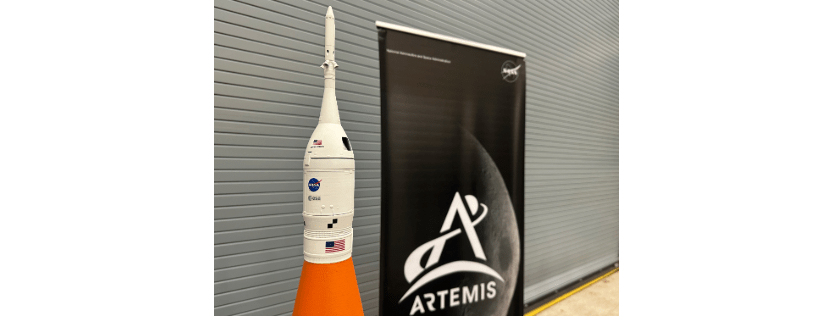Countdown to Artemis II: Kennedy Space Center Receives Huntsville-Made SLS Hardware for Mission to the Moon
Marshall Space Flight Center (MSFC) recently reached a significant milestone for the Artemis II mission by completing and successfully delivering the OSA (Orion stage adapter) to Kennedy Space Center in Florida on Tuesday, August 19.
Entirely built and assembled at MSFC, the OSA connects the SLS (Space Launch System) rocket’s interim cryogenic propulsion stage to NASA’s Orion spacecraft. A diaphragm inside the adapter provides a barrier and protects Orion and its crew from gases generated during launch.
Monique Wallace, OSA deputy lead, described MSFC’s involvement in completing the project.
“The panels were welded here, everything was painted here, all done by Marshall partners,” Wallace said.
Wallace noted that her team is dedicated to ensuring every component meets the highest standards.
“We’ve been focusing on making quality hardware. We want to put the best products,” Wallace said.
The OSA is located at the very top of the SLS rocket. Also, the hardware can carry CubeSats, shoebox-sized satellites that support science experiments and technology demonstrations.
During Artemis II, four CubeSats from NASA partners will be deployed around Earth as Orion continues its journey to the moon.
The adapter will remain at NASA Kennedy’s Multi-Payload Processing Facility for CubeSat integration before moving to the Vehicle Assembly Building, where it will then be stacked on the SLS rocket.
For AJ Gallemore, NASA Composite Materials and Processes Engineer, the opportunity to work directly with Artemis hardware is a career highlight.
“It’s really exciting to be able to work on supply hardware. It’s not something that everyone gets to do throughout their career. Having the SLS Artemis mission come through our center, being able to be hands-on with the hardware is unlike anything else,” Gallemore said.
He also emphasized the intense teamwork that it takes to get a complex project like the OSA completed successfully.
“It takes a lot of work, a lot of teams, analysis, manufacturing … everyone’s involved and works together every day to make this hardware happen,” Gallemore said.
Russell Lane, SLS payload integration lead, said the data from CubeSat payloads flying on Artemis II will pave the way for scientific endeavors on future missions to the moon.
“It’ll give us good insight into ‘How does radiation affect human tissue?’ How does radiation affect electrical components that can be used on future lunar missions based on the design of the mission?'” Lane said.
Lane continued, saying the CubeSat payloads could potentially help with “… establishing and verifying long-range communication links, and future mission design optimization.”
If Artemis II goes as planned, Artemis III will launch mid-2027 and will be the first time humans will explore the lunar South Pole region. The journey to the moon and back will take around 30 days total.
While it’s not ready to ship to Kennedy yet, the MSFC also built and assembled the OSA for Artemis III.
According to Gallemore, the Artemis III OSA is ready for the next phase of the process, integrating items such as the secondary payload brackets, the composite diaphragm, and other wiring and instrumentation.
The Artemis II test flight will take four crew members to the moon in April 2026 for a 10-day mission. It is NASA’s first crewed mission for establishing a long-term presence on the moon.
Marshall Space Flight Center (MSFC) continues to play a pivotal role in NASA’s Artemis program, managing the SLS.
MSFC’s responsibilities for the SLS include:
- Advanced manufacturing
- Vehicle design and analysis
- Systems engineering and integration
- Secondary payloads
- Structural strength and dynamics testing
- Flight software development and hardware-in-the-loop testing
- Space flight imaging systems and sensors
- Concept and trade study to support future SLS evolvability and missions
Local businesses interested in collaborating with MSFC on Artemis or other NASA initiatives can attend the center’s 40th Small Business Alliance event on Thursday, September 25. The event will provide insight into MSFC’s capabilities, guidance on partnering opportunities, and valuable networking with Redstone Arsenal commands, as well as large and small prime contractors.














